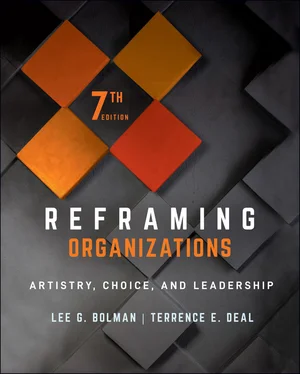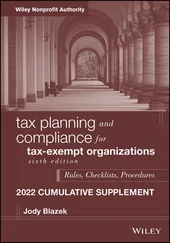The idea of reframing continues to be a central theme. Throughout the book, we show how the same situation can be viewed in at least four unique ways. In Part Six, we include a series of chapters on reframing critical organizational issues such as leadership, change, and ethics. Two chapters are specifically devoted to reframing real‐life situations.
We also continue to emphasize artistry. Overemphasizing the rational and technical side of an organization often contributes to its decline or demise. Our counterbalance emphasizes the importance of art in both management and leadership. Artistry is neither exact nor precise; the artist interprets experience, expressing it in forms that can be felt, understood, and appreciated. Art fosters emotion, subtlety, and ambiguity. An artist represents the world to give us a deeper understanding of what is and what might be. In modern organizations, quality, commitment, and creativity are highly valued but often hard to find. They can be developed and encouraged by leaders or managers who embrace the expressive side of their work.
As its title implies, the first part of the book, “Making Sense of Organizations,” focuses on sense‐making and tackles a perplexing question about management: Why is it that smart people so often do dumb things? Chapter 1, “Introduction: The Power of Reframing,” explains why: Managers often misread situations. They have not learned how to use multiple lenses to get a better sense of what they're up against and what they might do. Chapter 2, “Simple Ideas, Complex Organizations,” uses well‐known cases (such as the Covid‐19 pandemic) to show how managers' everyday thinking and theories can lead to catastrophe. We explain basic factors that make organizational life complicated, ambiguous, and unpredictable; discuss common fallacies in managerial thinking; and spell out criteria for more effective approaches to diagnosis and action.
Part Two, “The Structural Frame,” explores the key role that social architecture plays in the functioning of organizations. Chapter 3, “Getting Organized,” describes basic issues that managers must consider in designing structure to fit an organization's goals, tasks, and context. It demonstrates why organizations—from Amazon to McDonald's to Harvard University—need different structures in order to be effective in their unique environments. Chapter 4, “Structure and Restructuring,” explains major structural pathologies and pitfalls. It presents guidelines for aligning structures to situations, along with cases illustrating successful structural change. Chapter 5, “Organizing Groups and Teams,” shows that structure is a key to high‐performing teams.
Part Three, “The Human Resource Frame,” explores the properties of both people and organizations, and what happens when the two intersect. Chapter 6, “People and Organizations,” focuses on the relationship between organizations and human nature. It shows how managers' practices and assumptions about people can lead either to alienation and hostility or to commitment and high motivation. It contrasts two strategies for achieving effectiveness: “lean and mean,” vs. “investing in people.” Chapter 7, “Improving Human Resource Management,” is an overview of practices that build a more motivated and committed workforce—including participative management, job enrichment, self‐managing workgroups, management of diversity, and organization development. Chapter 8, “Interpersonal and Group Dynamics,” presents an example of interpersonal conflict to illustrate how managers can enhance or undermine relationships. It also discusses emotional intelligence and how group members can increase their effectiveness by attending to group process, including informal norms and roles, interpersonal conflict, leadership, and decision making.
Part Four, “The Political Frame,” views organizations as arenas. Individuals and groups compete to achieve their parochial interests in a world of conflicting viewpoints, scarce resources, and struggles for power. Chapter 9, “Power, Conflict, and Coalition,” opens with two classic cases of organizational tragedy: the management errors that grounded Boeing's 737MAX aircraft, and the tragic loss of the Space Shuttle Challenger , illustrating the influence of political dynamics in decision making. The chapter shows how scarcity and diversity lead to conflict, bargaining, and games of power; it also distinguishes constructive and destructive political dynamics. Chapter 10, “The Manager as Politician,” uses leadership examples from Jacinda Ardern in New Zealand and a software development effort at Microsoft to illustrate the basic skills of the constructive politician: diagnosing political realities, setting agendas, building networks, negotiating, and making choices that are both effective and ethical. Chapter 11, “Organizations as Political Arenas and Political Agents,” highlights organizations as both arenas for political contests and political actors influencing broader social, political, and economic trends. Case examples such as Walmart and Ross Johnson explore political dynamics both inside and outside organizations.
Part Fiveexplores the symbolic frame. Chapter 12, “Organizational Symbols and Culture,” spells out basic symbolic elements in organizations: myths, heroes, metaphors, stories, humor, play, rituals, and ceremonies. It defines organizational culture and shows its central role in shaping performance. The power of symbol and culture is illustrated in cases as diverse as the U.S. Congress, Nordstrom department stores, the U.S. Air Force, Zappos, and a unique horse race in Italy. Chapter 13, “Culture in Action,” uses the case of a computer development team to show what leaders and group members can do collectively to build a culture that bonds people in pursuit of a shared mission. Initiation rituals, specialized language, group stories, humor and play, and ceremonies all combine to transform diverse individuals into a cohesive team with purpose, spirit, and soul. Chapter 14, “Organization as Theater,” draws on dramaturgical and institutional theory to reveal how organizational structures, activities, and events serve as secular dramas, expressing our fears and joys, arousing our emotions, and kindling our spirit. It also shows how organizational structures and processes—such as planning, evaluation, and decision making—are often more important for what they express than for what they accomplish.
Part Six, “Improving Leadership Practice,” focuses on the implications of the frames for central issues in managerial practice, including leadership, change, and ethics. Chapter 15, “Integrating Frames for Effective Practice,” shows how managers can blend the frames to improve their effectiveness. It looks at organizations as multiple realities and gives guidelines for aligning frames with situations. Chapter 16, “Reframing in Action,” presents four scenarios, or scripts, derived from the frames. It applies the scenarios to the harrowing experience of a young manager whose first day in a new job turns out to be far more challenging than she expected. The discussion illustrates how leaders can expand their options and enhance their effectiveness by considering alternative approaches. Chapter 17, “Leadership in Theory and Practice,” discusses limitations in traditional views of leadership and proposes a more comprehensive view of how leadership works in organizations. It summarizes and critiques current knowledge on the characteristics of leaders, including the relationship of leadership to culture and gender. Chapter 18, “Reframing Leadership”, shows how frames generate distinctive images of effective leaders as architects, servants, advocates, and prophets.
Chapter 19, “Reframing Change in Organizations,” describes four fundamental issues that arise in any change effort: individual needs, structural alignment, political conflict, and existential loss. It uses cases of successful and unsuccessful change to document key strategies, such as training, realigning, creating arenas, and using symbol and ceremony. Chapter 20, “Reframing Ethics and Spirit,” discusses four ethical mandates that emerge from the frames: excellence, caring, justice, and faith. It argues that leaders can build more ethical organizations through gifts of authorship, love, power, and significance. Chapter 21, “Bringing It All Together,” is an integrative treatment of the reframing process. It takes a troubled school administrator through a weekend of reflection on critical difficulties he faces. The chapter shows how reframing can help managers move from feeling confused and stuck to discovering a renewed sense of clarity and confidence. The Epilogue ( Chapter 22) describes strategies and characteristics needed in future leaders. It explains why they will need an artistic combination of conceptual flexibility and commitment to core values. Efforts to prepare future leaders have to focus as much on spiritual as on intellectual development.
Читать дальше

![Lee Jungmin - Хвала Орку 1-128 [некоммерческий перевод с корейского]](/books/33159/lee-jungmin-hvala-orku-1-thumb.webp)










